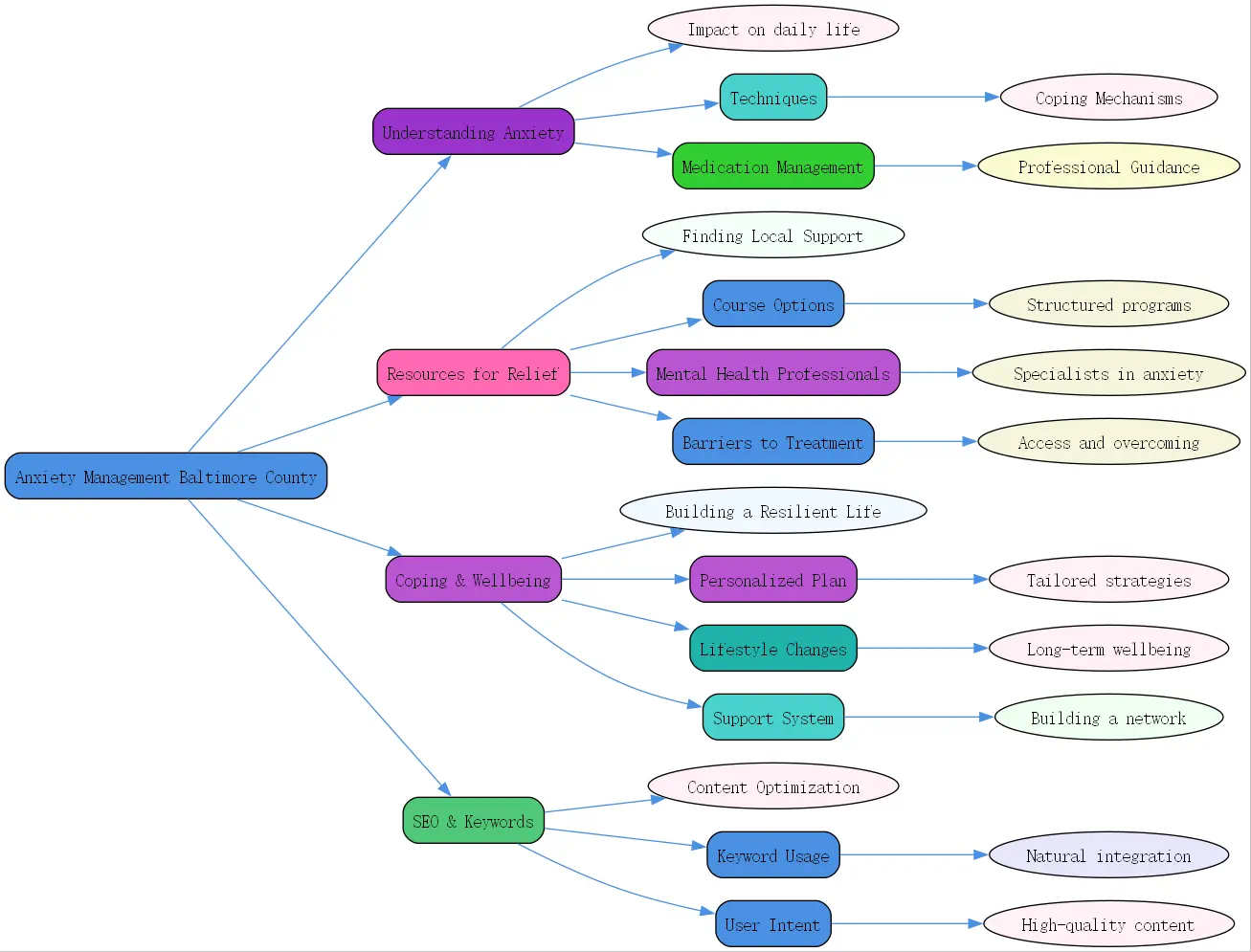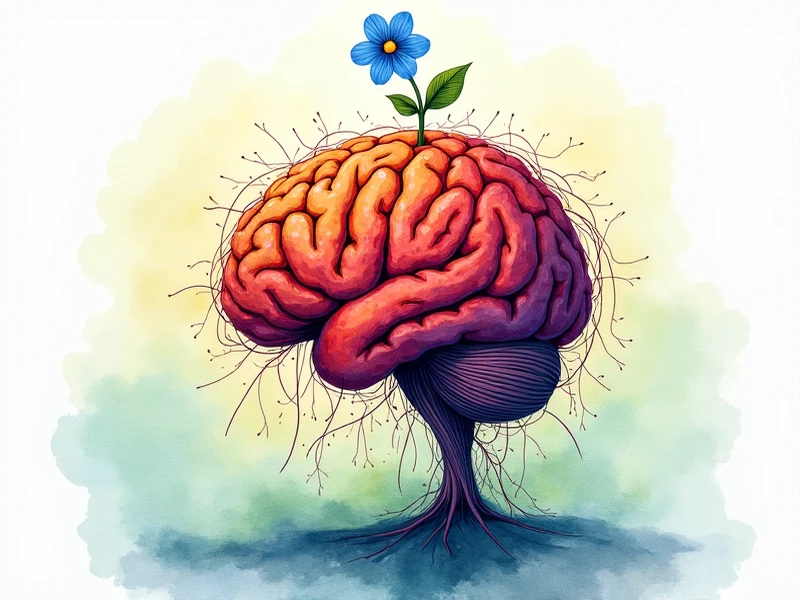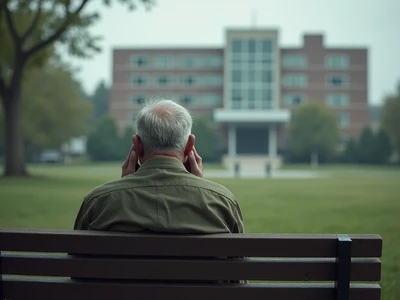Anxiety Management in Baltimore County: Finding Relief and Support

Living with anxiety can feel overwhelming, like constantly battling intrusive thoughts or physical sensations you can’t control. Many people feel like they’re “”white knuckling it,”” just trying to get through the day. If you’re seeking anxiety management support in Baltimore County, know that you’re not alone, and effective help is available. As experts at BrainTalking, we understand the complexities of anxiety and are here to guide you toward finding calm and regaining control. Remember, acknowledging you need help isn’t weakness; it’s a sign of strength.
It’s crucial to recognize that “”it’s okay to not be okay.”” Anxiety is often a chronic condition requiring ongoing management, not a personal failing. Finding healthy ways to express feelings, rather than holding them in, is a significant step towards healing. Seeking professional help doesn’t mean you’re broken; it often means you’re highly attuned and ready to understand yourself better.
Understanding Anxiety and Its Impact
Anxiety is more than just occasional worry or stress. It’s a persistent feeling of unease, fear, or apprehension that can significantly interfere with daily life. While stress is often tied to specific external pressures, anxiety can linger even when the trigger isn’t apparent, sometimes creating scenarios that haven’t even happened. It’s a complex condition that demands understanding and targeted management strategies.
Defining Anxiety: More Than Just Feeling Stressed
Anxiety often manifests as excessive worry that’s difficult to control and disproportionate to the actual situation. It can feel like your brain simply won’t shut down, constantly running through “”what ifs.”” This persistent mental state can drain your energy, affect concentration, and make everyday tasks feel monumental. Unlike temporary stress, anxiety disorders involve ongoing symptoms that impact functioning.
Recognizing the Symptoms: Physical, Emotional, and Behavioral Manifestations
Anxiety doesn’t just live in the mind; it profoundly affects the body. Physical symptoms can include a racing heart (“”beating out of my chest””), shortness of breath, muscle tension (like clenching your jaw or grinding teeth), trembling, sweating, nausea, or even feeling numb or frozen. Emotionally, you might feel constantly on edge, irritable, overwhelmed, or experience panic attacks. Behaviorally, anxiety can lead to avoidance of situations, social withdrawal, or difficulty sleeping.
The Multifactorial Nature of Anxiety: Biology, Genetics, and Life Events
There isn’t a single cause for anxiety; it’s typically multifactorial. Biology plays a role, involving brain chemistry and structure. Genetics are also significant 閳?if close family members have anxiety, your risk might be higher. Life events, especially traumatic experiences (like those leading to PTSD, as mentioned in the reference text), chronic stress, or major life changes, can trigger or exacerbate anxiety symptoms in susceptible individuals.
Anxiety disorders under five major categories
It’s helpful to know that anxiety isn’t monolithic. Mental health professionals categorize anxiety disorders into five major types: Generalized Anxiety Disorder (GAD), Obsessive-Compulsive Disorder (OCD), Panic Disorder, Post-Traumatic Stress Disorder (PTSD), and Social Anxiety Disorder (Social Phobia). Understanding these distinctions helps tailor effective treatment plans, addressing the specific ways anxiety manifests for each individual seeking help.
Effective Anxiety Management Techniques
Managing anxiety often involves a combination of strategies tailored to individual needs. Finding what works for you might take experimentation, but various evidence-based techniques can significantly reduce symptoms and improve quality of life. It’s about building a toolkit of coping mechanisms you can rely on when anxiety flares up.
Anxiety Stress Management Techniques: A Holistic Approach
Effective anxiety stress management techniques often take a holistic view, addressing mind, body, and lifestyle. This means looking beyond just one solution and integrating multiple approaches. Techniques might include relaxation exercises, stress-reduction strategies learned in therapy, lifestyle adjustments like diet and exercise, and building a strong support network. The goal is sustainable, long-term well-being.
The Power of Mindfulness and Meditation for Anxiety Relief
Mindfulness and meditation practices train your brain to focus on the present moment without judgment, helping to break the cycle of anxious thoughts. Regularly practicing meditation can help manage stress, reduce rumination, and increase self-awareness. Even short daily sessions can cultivate a sense of calm and provide a tool to ground yourself during moments of heightened anxiety.
Cognitive Behavioral Therapy (CBT) for Identifying and Changing Negative Thought Patterns
Cognitive Behavioral Therapy (CBT) is a highly effective form of talk therapy for anxiety. It focuses on identifying distorted or unhelpful thought patterns that contribute to anxiety and learning skills to challenge and change them. CBT also addresses behaviors associated with anxiety, such as avoidance, helping you gradually face feared situations in a safe, structured way.
The importance of acknowledging and accepting anxiety
A crucial step, highlighted by personal experiences in the reference text, is the “”acknowledgment and the acceptance that it’s there and that it’s a part of who I am.”” Fighting anxiety often creates a vicious cycle. Accepting its presence, without judgment, can paradoxically reduce its power. This acceptance paves the way for learning effective management strategies rather than being consumed by the struggle against it.
Deep breathing and exercise for anxiety reduction
Simple yet powerful tools include deep breathing exercises, which activate the body’s relaxation response, calming the nervous system quickly. Regular physical exercise is also a potent anxiety reducer. It releases endorphins, improves mood, reduces muscle tension, and helps regulate sleep 閳?all contributing factors to better anxiety management. Finding an activity you enjoy makes it easier to stick with.
Exploring Anxiety Medication Management
For some individuals, especially those with moderate to severe anxiety, therapy and lifestyle changes alone may not be sufficient. In these cases, medication can be a valuable tool to help manage symptoms and make therapy more effective. Decisions about medication should always be made in consultation with a qualified healthcare provider.
When is Medication Necessary for Anxiety?
Anxiety medication management becomes a consideration when symptoms significantly impair daily functioning 閳?affecting work, relationships, or self-care 閳?despite trying other strategies. It might also be necessary when anxiety co-occurs with other conditions like depression, or when physical symptoms are debilitating. Medication can help stabilize mood and reduce symptom intensity, creating space to engage effectively in therapy.
Types of Anxiety Medications: SSRIs, SNRIs, and Tricyclics
Commonly prescribed medications include Selective Serotonin Reuptake Inhibitors (SSRIs) and Serotonin-Norepinephrine Reuptake Inhibitors (SNRIs), which work by adjusting brain chemistry. Older medications like Tricyclic Antidepressants (TCAs) are sometimes used but often have more side effects. Benzodiazepines may be prescribed for short-term relief but carry risks of dependence. Finding the right medication and dosage often requires patience and monitoring.
Ketamine Infusions: A Novel Approach for Treatment-Resistant Anxiety
For individuals who haven’t found relief with traditional treatments, newer options like Ketamine infusions are emerging. Research suggests Ketamine can offer rapid relief for depression and anxiety symptoms, potentially by promoting neuroplasticity 閳?the brain’s ability to rewire itself. While promising, with reported success rates around 70-80% in some studies, it’s typically considered after other options have been explored and administered under strict medical supervision.
Combined Methods: Therapy with Medication for Anxiety
Extensive research and clinical experience indicate that combining psychotherapy (like CBT) with medication often yields the best results for moderate to severe anxiety disorders. Medication can alleviate acute symptoms, making it easier for individuals to engage in and benefit from therapy, where they learn long-term coping skills. This integrated approach addresses both the biological and psychological aspects of anxiety.
The importance of checking in with a therapist
Whether considering medication or relying solely on therapy and lifestyle changes, regular check-ins with a therapist or counselor are vital. Therapy provides a space to process experiences, learn skills, monitor progress, adjust treatment plans, and receive support. It helps ensure your anxiety management strategy remains effective and adapted to your evolving needs.

Resources for Anxiety Relief in Baltimore County
Finding the right support locally is crucial for effective anxiety management in Baltimore County. Numerous resources are available, from structured courses and support groups to individual therapy providers. Knowing where to look can empower you to take the next step towards feeling better.
Anxiety Management Course Options
Structured programs can provide valuable skills and support in a group setting or through self-paced learning. These courses often focus on specific techniques and provide a roadmap for managing anxiety.
Local Anxiety Support Groups and Workshops
Connecting with others who understand what you’re going through can be incredibly validating. Local support groups and workshops in the Baltimore County area offer peer support, shared experiences, and practical coping strategies. Check community centers, hospitals, or mental health organizations for listings.
Online Anxiety Management Programs
For flexibility and convenience, numerous online anxiety management course options exist. These range from app-based mindfulness programs to comprehensive CBT courses delivered digitally. Reputable platforms often offer evidence-based content developed by mental health professionals, allowing you to learn at your own pace from home.
Finding the Right Course for Your Needs
Consider your learning style, time availability, and specific goals when choosing a course. Do you prefer group interaction or individual learning? Are you looking for general stress reduction or specific techniques like CBT? Research course content, instructor qualifications, and reviews to find the best fit for your journey in Baltimore County.
Mental Health Professionals Specializing in Anxiety
Seeking professional help is a cornerstone of effective anxiety management. Baltimore County has many qualified therapists, counselors, and psychiatrists specializing in anxiety disorders.
Therapists, Counselors, and Psychiatrists in Baltimore County
Therapists and counselors provide talk therapy (psychotherapy), helping you understand your anxiety and develop coping skills. Psychiatrists are medical doctors who can diagnose conditions, prescribe medication (anxiety medication management), and monitor its effects. Many professionals offer integrated care. Look for licensed providers (LCPC, LCSW-C, PhD, PsyD, MD) in local directories or through insurance panels.
Finding a Therapist Who Understands Your Specific Anxiety Concerns
Look for therapists with experience treating your specific type of anxiety (e.g., GAD, social anxiety, PTSD). Consider factors like therapeutic approach (CBT, ACT, psychodynamic), personality fit, and practicalities like location and insurance. Don’t hesitate to consult with a few therapists before committing. BrainTalking, for instance, can connect you with professionals skilled in various anxiety presentations.
How to cope with anxiety behind closed doors
Many people initially try to cope alone, “”behind closed doors,”” as mentioned in the reference materials. While self-help strategies are useful, professional guidance can provide tailored tools and prevent maladaptive coping. A therapist can help you understand the roots of your anxiety and build sustainable, healthy coping mechanisms, moving beyond simply trying to “”white knuckle”” through it.
Overcoming Barriers to Treatment

Despite the availability of effective treatments, various barriers can prevent people from seeking help. Addressing these obstacles is essential for improving access to care.
Addressing the Stigma Surrounding Mental Health
Unfortunately, stigma still surrounds mental health conditions like anxiety. Fear of judgment or being seen as “”weak”” prevents many from seeking help. Open conversations, education, and sharing personal stories help normalize mental health struggles and encourage people to prioritize their well-being without shame. Remember, seeking treatment is a proactive step towards health.
The Effectiveness of Combined Methods in Managing Anxiety
As highlighted earlier, combining therapy (like CBT) with medication (when appropriate) is often the most effective approach, especially for more severe anxiety. Understanding this evidence can help overcome reluctance towards either treatment modality. Lifestyle changes and self-care strategies further bolster this integrated approach for comprehensive management.
Affording Anxiety Treatment: Insurance and Payment Options
Cost can be a significant barrier. Check your health insurance policy for mental health coverage details, including co-pays and deductibles for therapy and medication. Many therapists offer sliding scale fees based on income. Community mental health centers in Baltimore County may provide lower-cost services. Explore all options to make treatment accessible.
Coping Strategies and Long-Term Wellbeing
Effective anxiety management isn’t just about treating symptoms; it’s about building a life resilient to anxiety’s impact. This involves developing personalized coping strategies and prioritizing long-term well-being through sustainable lifestyle choices and strong support systems.
Developing a Personalized Anxiety Management Plan
A one-size-fits-all approach rarely works for anxiety. Creating a personalized plan involves understanding your unique triggers, patterns, and effective coping mechanisms.
Identifying Your Triggers and Warning Signs
Pay attention to situations, thoughts, or physical sensations that tend to precede increased anxiety. Recognizing your personal triggers (e.g., deadlines, social events, lack of sleep) and early warning signs (e.g., muscle tension, irritability) allows you to intervene proactively before anxiety escalates significantly. Keeping a journal can be helpful for identifying these patterns.

Creating a Daily Routine That Promotes Calmness and Relaxation
Structure and predictability can be comforting when dealing with anxiety. Incorporate calming activities into your daily routine, such as a few minutes of meditation in the morning, a relaxing walk after work, or winding down with a book before bed. Consistency helps regulate your nervous system and provides anchors throughout the day.
Incorporating Hobbies and Activities You Enjoy
Engaging in hobbies and enjoyable activities provides a necessary outlet for stress and fosters positive emotions. As noted in the reference text, coping skills can often be viewed as hobbies. Whether it’s painting, gardening, playing music, or spending time in nature, make time for activities that bring you joy and allow you to disconnect from anxious thoughts.
The Role of Lifestyle Changes in Anxiety Management
Your daily habits significantly influence your mental health. Making conscious choices about sleep, nutrition, and exercise can create a strong foundation for managing anxiety.
Prioritizing Sleep and Healthy Eating Habits
Lack of sleep dramatically impacts mood and increases vulnerability to anxiety. Aim for 7-9 hours of quality sleep per night by establishing a consistent sleep schedule and relaxing bedtime routine. A balanced diet rich in fruits, vegetables, whole grains, and lean protein also supports stable mood and energy levels, while limiting processed foods and sugar can prevent energy crashes that worsen anxiety.
The Benefits of Regular Exercise for Reducing Anxiety
Regular physical activity is one of the most effective natural anxiety relievers. Exercise releases feel-good endorphins, reduces stress hormones, improves sleep quality, and boosts self-esteem. Aim for at least 30 minutes of moderate-intensity exercise most days of the week. Find an activity you genuinely enjoy to ensure consistency.
Limiting Caffeine and Alcohol Consumption
While caffeine can provide a temporary energy boost, it often exacerbates anxiety symptoms like jitteriness and racing thoughts. Alcohol might seem like a relaxant initially, but it can disrupt sleep and lead to increased anxiety (hangxiety) later. Moderating or eliminating these substances can make a noticeable difference in anxiety levels.
Building a Support System
Navigating anxiety is easier when you have people you can rely on for understanding and encouragement. Cultivating a strong support network is vital for long-term well-being.
Connecting with Friends, Family, and Support Groups
Lean on trusted friends and family members. Sharing your experiences, even just saying “”I’m not feeling okay today,”” can provide immense relief. Connecting with others who understand anxiety, perhaps through local Baltimore County support groups or online communities, reminds you that you are not alone in your struggles.
Sharing Your Experiences and Seeking Encouragement
Don’t be afraid to ask for what you need from your support system, whether it’s a listening ear, practical help, or simply encouragement. Sometimes, just knowing someone cares and understands can make a difficult day more manageable. Reciprocity and understanding are key components of supportive relationships.
Embracing Self-Care and Practicing Self-Compassion
Treat yourself with the same kindness and understanding you would offer a friend struggling with anxiety. Acknowledge that managing anxiety is challenging and that it’s okay to have difficult days. Prioritize self-care activities that nourish your mind and body, and practice self-compassion, especially during setbacks. Remember, you are worthy just as you are.
Q&A: Understanding Keyword Usage in SEO Content
Q: How important is it to use the exact keyword phrase like “”anxiety management baltimore county“” multiple times in an article?
A: It’s important, but natural integration is key. Search engines like Google are sophisticated and understand synonyms and related concepts (semantic search). While including your primary keyword (“”anxiety management baltimore county””) helps signal the topic’s relevance, especially for local searches, repeating it excessively or unnaturally (keyword stuffing) can harm readability and even incur SEO penalties.
Best practice involves: 1. Strategic Placement: Include the exact keyword in crucial areas like the title tag, meta description, H1 heading, introduction, and conclusion, if it fits naturally. 2. Natural Variation: Use variations (e.g., “”anxiety support in Baltimore County,”” “”managing anxiety near Baltimore,”” “”Baltimore County anxiety treatment””) and related terms (“”anxiety stress management techniques,”” “”local therapists,”” “”anxiety medication management””). 3. Focus on User Intent: Prioritize creating high-quality, comprehensive content that genuinely answers the user’s query about finding anxiety management resources in Baltimore County. Relevance and value are more important than hitting an arbitrary keyword count. Using the keyword naturally 2-3 times, alongside variations, is usually sufficient for a well-optimized article.




